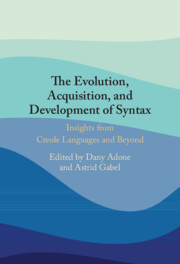Book contents
- The Evolution, Acquisition, and Development of Syntax
- The Evolution, Acquisition, and Development of Syntax
- Copyright page
- Contents
- Figures
- Tables
- Contributors
- Acknowledgments
- Abbreviations
- 1 Introduction
- Part I The Evolution of Syntax
- 2 From the Protolanguage Spectrum to the Underlying Bases of Language
- 3 From Protolanguage to Deuterolanguage: The Importance of Compounds
- 4 The SOV Mystery and Language Evolution
- 5 Broken Windows: Creoles, Pidgins, and Language Evolution
- 6 Roots of Syntax: Anaphora and Negation in Creoles
- Part II The Acquisition of Syntax
- Part III The Development of Syntax
- Index
- References
6 - Roots of Syntax: Anaphora and Negation in Creoles
from Part I - The Evolution of Syntax
Published online by Cambridge University Press: 19 February 2025
- The Evolution, Acquisition, and Development of Syntax
- The Evolution, Acquisition, and Development of Syntax
- Copyright page
- Contents
- Figures
- Tables
- Contributors
- Acknowledgments
- Abbreviations
- 1 Introduction
- Part I The Evolution of Syntax
- 2 From the Protolanguage Spectrum to the Underlying Bases of Language
- 3 From Protolanguage to Deuterolanguage: The Importance of Compounds
- 4 The SOV Mystery and Language Evolution
- 5 Broken Windows: Creoles, Pidgins, and Language Evolution
- 6 Roots of Syntax: Anaphora and Negation in Creoles
- Part II The Acquisition of Syntax
- Part III The Development of Syntax
- Index
- References
Summary
O’Grady’s chapter discusses a recurring theme in Derek Bickerton’s work on creoles which focused on his observation, now somewhat controversial, that their morphosyntactic properties are surprisingly similar, which he attributed to a ‘language bioprogram’ bearing a close resemblance to Universal Grammar. O’Grady’s chapter explores a different line of reasoning by considering the role that processing pressures play in the syntax of creoles – and of human language in general. Drawing on data from anaphora and negation, both of which are well-documented core syntactic phenomena in natural language, he argues that their signature properties are shaped by considerations of computational efficiency and economy that can be traced to the need to minimize the burden on working memory.
- Type
- Chapter
- Information
- The Evolution, Acquisition and Development of SyntaxInsights from Creole Languages and Beyond, pp. 96 - 116Publisher: Cambridge University PressPrint publication year: 2025

